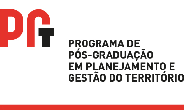Banca de QUALIFICAÇÃO: LUIZ HENRIQUE WERNECK DE OLIVEIRA
Uma banca de QUALIFICAÇÃO de DOUTORADO foi cadastrada pelo programa.DISCENTE : LUIZ HENRIQUE WERNECK DE OLIVEIRA
DATA : 29/07/2019
HORA: 14:00
LOCAL: sala S24,Térreo, Bl. Delta,Campus SBC, Al .da Universidade. s/n, B.Anchieta-S.Bernardo do Campo-SP
TÍTULO:
THE CONFLICT BETWEEN AIRPORTS AND CITIES: THE ROLE OF URBAN AND REGIONAL PLANNING IN LARGE WORLD METROPOLISES - SÃO PAULO AND LOS ANGELES
PÁGINAS: 195
GRANDE ÁREA: Ciências Sociais Aplicadas
ÁREA: Planejamento Urbano e Regional
SUBÁREA: Métodos e Técnicas do Planejamento Urbano e Regional
ESPECIALIDADE: Técnicas de Planejamento e Projeto Urbanos e Regionais
RESUMO:
The conflict between airports and cities is inevitable, opposes users to non-users, and demands solving and juxtaposing distinct objectives in urban planning. Airports are different to other urban equipment triggering neighborhood opposition, as they involve substantial capital expenditures and by generating impacts that far transcend their physical limits. It is where local, regional, and global scales intertwine, the latter leveraged by neoliberal hegemony. Formerly taken as countries’ gateways, airports now form complex networks of centralizing hubs and feeder spokes that not always coincide with the networks of cities, affecting character, duration and complexity of the conflicts. Aviation grows exponentially, demanding expansion of airport capacity and magnifying their negative externalities. In a much more urbanized world, the conflicts aggravate, imposing new challenges to planners. Processes of airports’ corporatization and privatization changed the reactions of the elements that cause the conflict, such as noise, pollution, safety, congestion etc. The studies initiate from the original hypothesis that such conflicts could be mitigated by the adoption of adequate land use planning and zoning around airports, allowing harmonic co-existence of the cities with these urban and/or metropolitan assets. It is observed, however, that neighborhoods planned in order to surround airports with compatible land uses do not necessarily allay the conflicts, as communities adjacent to such areas planned to be compatible with the airports’ activities may be affected by take-off and approach routes, retriggering the conflict. Based on information from over 900 airports worldwide, examples of conflicts are evaluated, selecting the cases of the metropolitan agglomerations of São Paulo and Los Angeles to further understand how the formation of such metropolises relates to the dynamics of air transport and with airport issues. Both cities have already rejected a proposed airport in their past, and have very busy airport systems. It is intended, as well, to comprehend how the conflicts between these airports and the metropolises and communities they serve configure and evolve. The objective is to highlight elements capable of contributing to the discussion of airports policies in urban planning, with emphasis to the Brazilian case, as well as to give some thought to the airports’ role on the processes of the formation of metropolises and multiple scale redefinitions.
MEMBROS DA BANCA:
Presidente - Interno ao Programa - 1764378 - SILVANA MARIA ZIONI




